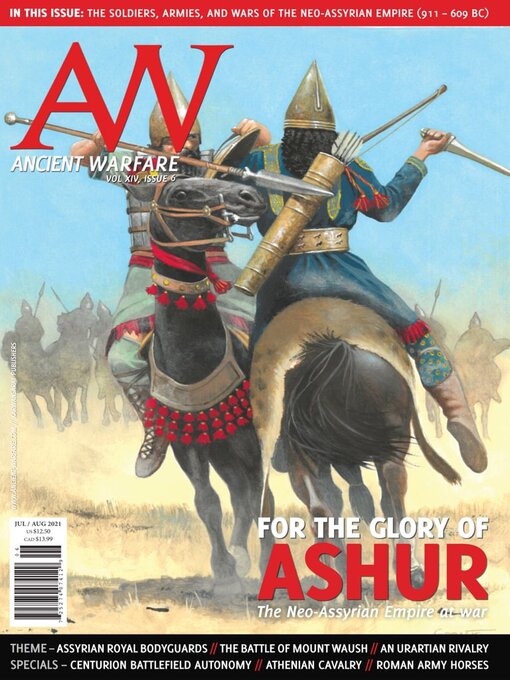Ancient Warfare is a unique publication focused exclusively on soldiers, battles, and tactics, all before 600 AD. Starting with ancient Egypt and Persia and continuing to the fall of the Western Roman Empire, Ancient Warfare examines the military history of cultures throughout Europe, the Middle East and parts of Asia and Africa. Ancient Greece and Rome receive the most frequent coverage, due both to the wealth of contemporary sources and the modern fascination with these two great civilizations. Subject-matter ranges from the familiar to the more obscure: while Alexander the Great, the Persian Wars and Caesar’s Gallic campaigns all receive regular coverage, Ancient Warfare also looks at some of the less common parts of ancient military history, from chariots as battle taxis to PTSD in antiquity.
ANCIENT WARFARE magazine
PRELIMINARIES
HAVE YOU READ? • OUR ANCIENT WARS: RETHINKING WAR THROUGH THE CLASSICS
QUINTUS SERTORIUS • We saw in the last article (AW 14.4) that there is much to explore in the remarkable career of Eumenes of Cardia, especially in his use of ‘false religion’ to survive such tribulations. The career of Quintus Sertorius offers parallels to Eumenes’ in many of the facets common to the two men’s lives, and it was upon this basis that their two lives were paired by the Greek biographer Plutarch.
MAKING THE CAVALRY • In Athens, cavalry was arguably often side-lined as a military service for the wealthy elite, or simply for those who were too cowardly to fight in the phalanx man to man. Modern scholarship has often argued their ineffectiveness. Yet, it seems that this perception may indeed be a modern failing.
THE WAY OF THE FUTURE • If ancient army studies were a party, the Neo-Assyrian army would be the guest who some other guests are deliberately ignoring. In the seventh century BC, the Assyrians were sending armies from the Tigris to the Nile while Greeks were squabbling with their neighbours about women and pastures. They had siege engineers and engines, and paid officials to collect and redistribute grain and silver and information. The Assyrian way of war was both firmly rooted in thousands of years of history, and a constantly changing practice that used the latest tools and techniques such as iron smelting and shooting the bow from horseback.
THE ASSYRIAN EMPIRE • A TIMELINE OF EVENTS (1049 - 614 BC)
ASSYRIA’S RIVAL • One of the most dangerous rivals to Assyrian power existed in what is now eastern Turkey and Armenia: the Kingdom of Urartu. In the second half of the eighth century BC, Urartu aspired to the hegemony of the lands stretching from Anatolia to Assyria’s northern borders. Its particular geography brought forth a state and an army that was different enough to the Assyrian model to cause serious difficulties for the army of Ashur.
THE QURBŪTU • The Assyrian king’s eyes and ears were a group of elite soldiers called qurbu-tu. Their name translates as ‘the close ones’ in Akkadian, indicating they were kept close to and were trusted by the king. The qurbu-tu-s variously served as bodyguards to the king, as an elite military force, and as a domestic intelligence agency monitoring the actions of all the officials of the empire.
LIKE A FURIOUS ARROW • Unlike accounts of Greek, Roman, and even Egyptian battles, Assyrian warfare has left us no narratives with which we can easily reconstruct how an Assyrian battle was fought. We do, however, have a rich archaeological record of reliefs, inscriptions, and other finds, which reveal several aspects of Assyrian warfare and campaigns. Used with care, these resources can be used to reconstruct how an Assyrian battle may have been fought.
The evolution of the Assyrian cavalry
BATTLEFIELD JUSTICE OF THE GOD ASHUR • From roughly 911 to 609 BC, a series of Assyrian monarchs, or “kings of all the four...

 AW XVIII.4
AW XVIII.4
 AW XVIII.3
AW XVIII.3
 AW XVIII.2
AW XVIII.2
 AW XVIII.1
AW XVIII.1
 AW XVII.6
AW XVII.6
 AW XVII.5
AW XVII.5
 AW XVII.4
AW XVII.4
 AW XVII.3
AW XVII.3
 AW XVII.2
AW XVII.2
 AW XVII.1
AW XVII.1
 AW XVI.6
AW XVI.6
 AW XVI.5
AW XVI.5
 AW XVI.4
AW XVI.4
 AW XVI.3
AW XVI.3
 AW XVI.2
AW XVI.2
 AW XVI.1
AW XVI.1
 AW XV.6
AW XV.6